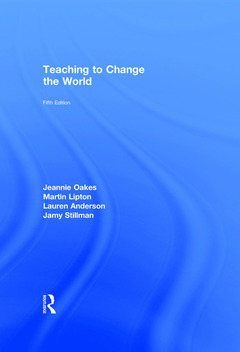Teaching to Change the World (5th Ed.)
Auteurs : Oakes Jeannie, Lipton Martin, Anderson Lauren, Stillman Jamy

Teaching to Change the World is an up-to-the-moment, engaging, social justice-oriented introduction to education and teaching, and the challenges and opportunities they present. Both foundational and practical, the chapters are organized around conventional topics but in a way that consistently integrates a coherent story that explains why schools are as they are. Taking the position that a hopeful, democratic future depends on ensuring that all students learn, the text pays particular attention to inequalities associated with race, social class, language, gender, and other social categories and explores teachers? role in addressing them.
This thoroughly revised fifth edition remains a vital introduction to the profession for a new generation of teachers who seek to become purposeful, knowledgeable practitioners in our ever-changing educational landscape?for those teachers who see the potential for education to change the world.
Features and Updates of the New Edition:
? Fully updated Chapter 1, "The U.S. Schooling Dilemma," reflects our current state of education after the 2016 U.S. presidential election.
? First-person observations from teachers, including first-year teachers, continue to offer vivid, authentic pictures of what teaching to change the world means and involves.
? Additional coverage of the ongoing effects of Common Core highlights the heated public discourse around teaching and teachers, and charter schools.
? Attention to diversity and inclusion is treated as integral to all chapters, woven throughout rather than tacked on as separate units.
? "Digging Deeper" resources on the new companion website include concrete resources that current and future teachers can use in their classrooms.
? "Tools for Critique" provides instructors and students questions, prompts, and activities aimed at encouraging classroom discussion and particularly engaging those students least familiar with the central tenets of social justice education.
List of Figures, Concept Tables, and Focal Points Preface Acknowledgments Part I: Democracy, Diversity, and Inequity 1. The U.S. Schooling Dilemma: Diversity, Inequity, and Democratic Values 2.History and Culture: How Expanding Expectations and Powerful Ideologies Shape Schooling in the United States 3. Politics and Philosophy: The Struggle over the School Curriculum 4. Policy and Law: Rules That Schools Live By Part II: The Practice of Teaching to Change the World 5. The Subject Matters: Constructing Knowledge Across the Content Areas 6. Instruction: Teaching and Learning Across the Content Areas 7. Assessment: Measuring What Matters 8. Classrooms as Communities: Developing Caring and Democratic Relationships Part III: The Context of Teaching to Change the World 9. The School Culture: Where Good Teaching Makes Sense 10. School Structure: Sorting Students and Opportunities to Learn 11. The Community: Engaging with Families and Neighborhoods 12. Teaching to Change the World: A Profession and a Hopeful Struggle Bibliography Index
Jeannie Oakes is Presidential Professor (Emeritus) in Educational Equity at UCLA's Graduate School of Education and Information Studies and founding director of UCLA's Center X: Where Research and Practice Intersect for Urban School Professionals.
Martin Lipton is an education writer and consultant, a communications analyst at UCLA's Institute for Democracy, Education, and Access, and a former public high school teacher.
Lauren Anderson is an associate professor of education at Connecticut College and a former upper-elementary teacher.
Jamy Stillman is an associate professor of educational equity and cultural diversity at the University of Colorado Boulder and a former bilingual elementary teacher.
Date de parution : 02-2018
17.8x25.4 cm
Date de parution : 02-2018
17.8x25.4 cm
Disponible chez l'éditeur (délai d'approvisionnement : 14 jours).
Prix indicatif 105,47 €
Ajouter au panierThème de Teaching to Change the World :
Mots-clés :
Young Man; social justice education; South Side High School; lauren anderson; Address LGBTQ Issue; jamy stillman; Pay For Performance; martin lipton; Structured English Immersion Classes; jeannie oakes; LGBTQ Youth; multicultural education; IQ Point; education theory; IQ Difference; Emergent Bilingual; National Academy; Lower 9th Ward; Kimberly Min; Vice Versa; University Of Wisconsin; Violates; Latinx Students; IQ Test; Professional Development; Education Policymaking Process; Emergent Bilingual Students; Deficit Thinking; Large Scale Assessments; Charter Schools; IQ Score; High Stakes Accountability Policies



